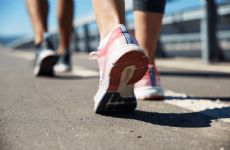|
Recently at the dailySpark, we have celebrated with Coach Nancy and Coach Jen as they successfully completed the Chicago Marathon. We have also heard about how their training motivated Coach Nicole and Coach Stepf to take up running to successfully complete a race as well. As an athlete I have run for conditioning for most of my life. After having thyroid surgery in 2002, I took up running more seriously as a mode and method for weight control. Between 2002 and 2004 I ran in several marathon relays and 5 K's as well as a mini-marathon and four half-marathons. Unfortunately, thyroid disease trumps half-marathon training and my weight slowly climbed up anyway. During the training, old ankle and knee injuries resurfaced as well. I also suffered a partial Achilles rupture while playing volleyball, which took me well over a year to rehabilitate. Because of all of this, I took a break from running and ventured into biking and other cross-training options. I seem to only find time to work out at 5:30 in the morning which leaves little opportunity for training challenge when you live in the suburbs. After several years of riding the same early morning routes, I had become burnt out on biking. With all the running talk swirling around the office, I had thoughts of taking up running again. After several weeks, many of those old injuries resurfaced and left me really sore and miserable for the rest of the day regardless of the workout duration and intensity. I tried switching to a run/walk method to see if that would work better. It was during that running to walking transition one morning that I re-discovered race walking. As a transitioned from a run to a walk I naturally slipped into the race walking gate briefly. I was first introduced to race walking back in college when a teammate showed us how to do it as an off-season training alternative. She was from Florida and it was somewhat popular down there and didn't get the strange looks that it did/does in the mid-west. After deciding that running and run/walking weren't really working, I did a little online research and decided to give race walking a try. Race walking has guiding definitions that sets it apart from running. According to the USA Track and Field Association, "race walking is a progression of steps so taken that the walker makes contact with the ground so that no visible (to the human eye) loss of contact occurs. The advancing leg must be (straightened - i.e., not bent at the knee) extended at the knee from the moment of first contact with the ground until the leg is in the vertical position." Does it sound confusing? It did to me too at first but to put it more simply, you must roll the entire length of your foot over the ground and one foot must always be touching the ground. There are many videos on the web that can help you see what that definition looks like in action. Technique is everything when learning to race walk and learning the proper technique in the beginning will not only help you with speed down the line, it will reduce your risks of injury as well. Beginning race walking pace is typically between 10:00 mins/mile to 15:00 mins/mile so there is plenty of room for speed improvement as your technique improves. I am currently at about a 13:00 mins/mile pace and able to comfortably go for a 3 mile race walk. My current goal is to get that 3 miles down to a 12 mins/mile pace. As you start race walking, try to make conscious transitions between regular walking, race walking, and running. In the beginning, it was difficult for me to tell when my form was correct. Then I would get frustrated because I would slip back and forth unknowingly between a racing walk and a regular walk. I would jog and then slip into my racing walk but as my legs would fatigue I would quickly fall into a regular walk. Take the signals your body is offering and the next walk try to go a little further in racing form. As your form improves and your muscle strength and stamina, you will find your stride begins to feel more smooth and deliberate. Be patient and take small steps. Because you will be using new muscles differently, be sure to focus your stretching time on the new muscle groups used in race walking. The piriformis is a small muscle in the buttocks that you don't really notice until it becomes aggravated when it can irritate the sciatic nerve. The IT Band consists of fibers running along the outside of the thigh between the gluteal muscles and the connective tissue below the knees. The shin muscles are also engaged more than in regular walking because of the deliberate heel strike and rolling motion of the foot. All of these areas are used differently in race walking and can easily become irritated and sore when you are starting out. Be sure to stretch well, include a proper warm up and cool down and work up slowly in your race walking time and training. Race walking provides many of the benefits of running without the pounding on your body. Race walking not only provides a challenge, it also is physically intense as you improve in form and speed providing a great cardio workout. If you have not been able to run for whatever reason but you are looking for something more challenging for your fitness than just a walk in the park, consider race walking. Experts say it takes about six weeks to learn with an efficient form and a lifetime to master. I agree that it takes time to learn and am looking forward to the challenges of mastery. Have you ever heard of race walking? Is it something you might try in your fitness routine? |
Popular Entries
More From SparkPeople
|


















.png)
.jpg)
